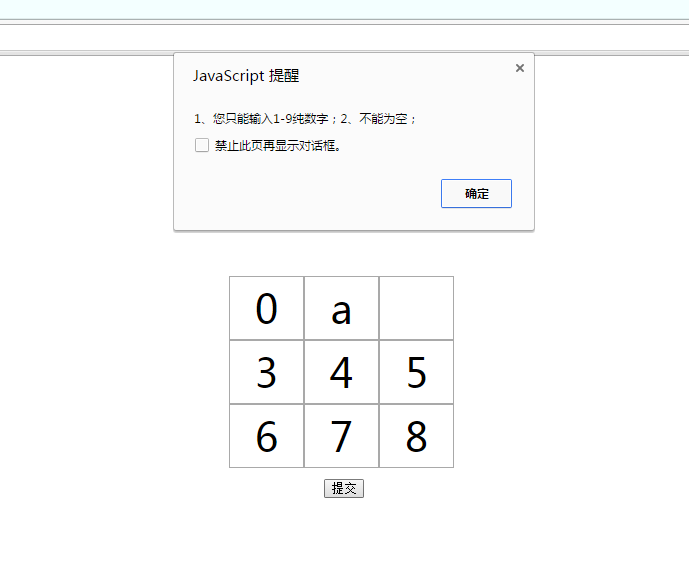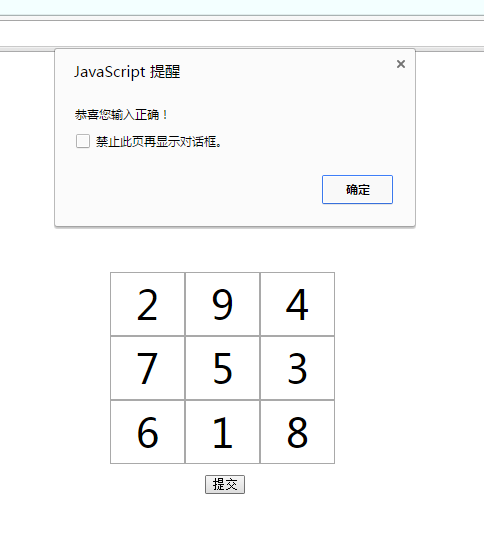
The example in this article introduces the corresponding method of realizing Jiugongge in JavaScript and shares it with everyone for your reference. The specific content is as follows
Implementation ideas:
1. The value entered in each grid must be a number;
2. The entered value cannot be repeated;
3. The input value cannot be less than 1 or greater than 9;
4. The value cannot be empty;
5. There are 8 addition methods in total, including three horizontally, three vertically, and two diagonal values. Details are as follows:

Explanation:
Use the serial number marked in each grid as an identifier:
Three horizontal values: 0-2, 3-4, 6-8;
Three vertical values: [0,3,6], [1,4,7], [2,5,8];
Two values on the diagonal: [0,4,8], [2,4,6]
Implementation process:
It's very simple, just like the picture above, click the submit button to start judging.
1. Layout
html part:
<div class="box"> <input type="text"> <input type="text"> <input type="text"> <input type="text"> <input type="text"> <input type="text"> <input type="text"> <input type="text"> <input type="text"> <button>提交</button> </div>
css part: implemented through attributes in css3.
*{margin:0;padding:0;outline: none;}
html,body{
height: 100%;
display: flex;
justify-content: center;
align-items: center;
}
.box{
position: relative;
width: 250px;
margin:0 auto;
}
input{
text-align: center;
font: 40px/60px 'Microsoft YaHei';
width: 30%;
float:left;
box-sizing:border-box
}
button{
position: absolute;
bottom:-30px;
left: 50%;
margin-left: -30px;
width: 40px;
}2. Next comes the focus, the js part
I have mentioned the implementation method of js before, here is the relevant code.
var oBtn=document.getElementsByTagName('button')[0],
aInp=document.getElementsByTagName('input');
function isNum(){
var aTemp=[];//创建临时函数,一次存放九宫格中的数字
for(i=0;i<aInp.length;i++)
{
var val=Number(aInp[i].value);
if(isNaN(val) || val<1 || val>9) {//判断当前输入框中数值是否是数字,是否小于1,是否大于9?
alert('1、您只能输入1-9纯数字;2、不能为空;');
return false;//若满足任意一条件直接退出函数不往下走
}
for(s=0;s<aTemp.length;s++){//循环判断九宫格内是否有重复数值,若是有重复直接推出函数
if(val == aTemp[s]){
alert('不能重复输入!');
return false;
}
}
//上述判断都满足,则将当前val的值放到数组aTemp中
aTemp.push(val);
}
//n后面所跟数字与上面图片每个格子标记的数值一致
//将横向与纵向的值设置为0;其中n1-n3为横向三个值,n4-n6为纵向三个值
var n1=0,n2=0,n3=0,n4=0,n5=0,n6=0,
//n7、n8分别为两对角值
n7=aTemp[0]+aTemp[4]+aTemp[8],
n8=aTemp[2]+aTemp[4]+aTemp[6];
//横向:分段相加值
for(i=0;i<3;i++)n1+=aTemp[i];
for(i=3;i<6;i++)n2+=aTemp[i];
for(i=6;i<9;i++)n3+=aTemp[i];
//纵向:因为纵向是每隔两个格子相加一次,所以正好用取模方式计算
for(i=0;i<9;i++){
(i%3==0) && (n4+=aTemp[i]);//当i%3=0时,分别为格子0、3、6
(i%3==1) && (n5+=aTemp[i]);//当i%3=1时,分别为格子1、4、7
(i%3==2) && (n6+=aTemp[i]);//当i%3=1时,分别为格子2、5、8
}
//判断n1-n8各值是否都相等,当然可以任意一个n判断,不局限只与n1的值相等
n1==n2 && n1==n3 && n1==n4 && n1==n5 && n1==n6 && n1==n7 && n1==n8 ? alert('恭喜您输入正确!') : alert('很遗憾您输入错误!');
}
oBtn.onclick=isNum;执行效果
1. When the input value is non-numeric, or greater than 9, or less than 0, or empty

2. When entering repeated numbers

3. When the input is correct

The above is the entire content of this article. I hope it will be helpful to everyone in learning javascript programming.




